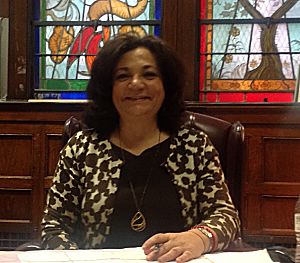How One New York City Principal Manages Smartphones in Class
 Nancy Amling is the founding principal of Hudson High School of Learning
Technologies, an Institute for Student Achievement (ISA) partner school located in Manhattan. Here, she talks about what will and won’t change at her school now that the New York City Department of Education has lifted its ban on smartphones on campus.
Nancy Amling is the founding principal of Hudson High School of Learning
Technologies, an Institute for Student Achievement (ISA) partner school located in Manhattan. Here, she talks about what will and won’t change at her school now that the New York City Department of Education has lifted its ban on smartphones on campus.
THE Journal: Do you have a 1-to-1 or BYOD program in place?
Amling: Yes, we are a device-agnostic 1-to-1 school. We provide a device to each of our students. We also have a program where students can sign out a device over the weekend so they are able to use technology at home which they otherwise may not have access to.
All of our programs are cloud-based, and we use Google Apps for Education for sharing information. All of our students, teachers and parents have an e-mail address through Google, and all of our information is shared online with faculty via our Professional Information Electronically blogs. We use an online gradebook for tracking grades and student progress, which is accessible to parents, students and educators from anywhere at any time. We are active on social media and have developed a significant Web presence, as well as a broad digital footprint.
With all of our school’s technology use, our focus is on teaching and learning. We incorporate technology — from having some students read for 30 minutes a day on a device to having them participate in a blogging activity — appropriately to enhance those processes.
THE Journal: Given how much technology is a part of your school, what was your reaction to the lifting of the cell phone ban in New York City schools?
Amling: I believe this is very important, and hopefully other districts will follow suit. In today’s world, communication is important. For one, I believe it is important for students to be able to communicate with their parents before, after or even sometimes during school, if need be. And secondly, cell phones, especially smartphones, have the power to be very valuable teaching and learning tools. The Department of Education’s recent decision acknowledges this.
THE Journal: What, if anything, will change in your school now that the ban has been lifted?
Amling: We will continue to incorporate technology into our teaching and learning processes in meaningful ways, and cell phones will be a part of that mix now. We need to be mindful that some students might not have smartphones, so we need to accommodate them to make sure all students are on a level playing field. For example, if we ask students to take notes on their phone or use it to take images of their project, we need to make sure other devices, such as an iPad or other school-provided device, is available so that all students can participate in those activities.
THE Journal: How do you plan to manage student use of devices?
Amling: We are a digital school: Almost all student work is online and we build the use of devices into our lessons. So, for us, the management of the devices will be very hands-off. We will not restrict students’ use of cell phones for learning purposes and will focus instead on managing our own teaching so students are engaged and challenged.
THE Journal: How do you teach digital citizenship? Will that change now that the ban has been lifted?
Amling: We have always focused on teaching our students the importance of digital responsibility. We discuss what they post on social media, finding and citing authentic sources, avoiding plagiarism, creating Web pages, managing files and working online. All of our senior students also leave Hudson HSLT with an online portfolio of their work. This project, as well as the skills mentioned, helps narrow the digital divide and helps prepare students for college and the workforce.
THE Journal: Other than Google Apps for Education, what tools might you use to help integrate smartphones into teaching and learning?
Amling: All of the tools we use are designed to enhance the teaching and learning processes. Some examples of these tools include Pupil Path, Blackboard and Naviance, which we receive through our partnership with ISA.
THE Journal: What software, if any, will you use to manage smartphones on campus?
Amling: Besides the Department of Education’s firewall, which blocks certain websites, there will be no formal management or restriction of students’ cell phone usage. We trust that our students will use the devices responsibly, as they do their laptops.
About the Author
Christopher Piehler is the former editor-in-chief of THE Journal.